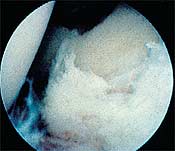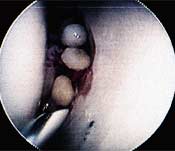Training, better instruments aid growth in hip arthroscopy
Better diagnoses and imaging contribute to the increased number of procedures being done worldwide
By 2004, a 70% increase over the more than 23,000 procedures that were done in the United States in 1999 is expected, according to a Millennium Research Group report. Orthopaedic surgeons attribute this growth to several factors, among them an increased number of patients who are being referred for such surgeries.
Further proof of this increase is that many hip arthroscopy patients being referred to Richard N. Villar, FRCS, of Cambridge England, have already undergone a hip arthroscopy elsewhere, which was not the case five years ago. “I do not think it is a rapid expansion … just a slow, steady one as more surgeons realize what hip arthroscopy has to offer,” Villar told Orthopaedics Today.
J.W. Thomas Byrd, MD, of Nashville Sports Medicine and Orthopaedic Center in Nashville, U.S.A., added, “We’ve developed the basic techniques for performing hip arthroscopy in a reliable and safe fashion. We’re also identifying many forms of intra-articular hip pathology that are amenable to arthroscopy that in the past basically went unrecognized and untreated.”
A minimally invasive alternative
Arthroscopy is an alternative to traditional hip arthrotomy for minimally invasive treatment of such conditions as loose bodies and osteophytes, Byrd said. “Many of the things that we’re now addressing through arthroscopy of the hip, like tearing of the acetabular labrum, articular surface injuries and rupture of the ligamentum teres, previously went undiagnosed.”
Other developments in this area include enhanced hip joint-specific imaging techniques, better trained arthroscopists and better instruments. Also, the recent advent of radio frequency (RF) probes has expanded the types of tools at the arthroscopist’s disposal.
Previously, some hip conditions now being detected through preoperative imaging were unseen by radiologists. Imaging techniques are improving, becoming more sensitive and specific for discerning intra-articular pathology. “Some [radiologists] are starting to be able to diagnose with noninvasive techniques such as MRI and gadolinium arthrography combined with MRI,” Byrd said.
Numbers growing
Byrd, who has performed hip arthroscopy for 13 years, performed approximately 70 to 80 hip arthroscopies in 2001, mostly on referred patients. “Where the growth is really occurring is we’re teaching [physicians] how to assess and diagnose hip joint problems,” Byrd said.
According to Villar, “There is a critical mass of surgeons now undertaking the operation and seeing the benefits of it. That is what is needed. It is the only way to make sense of the procedure and properly analyze the results.”
Recently, Villar had several professional athletes referred to him for treatment. “Football players seem to be particularly prone to labral tears, with or without articular cartilage damage to the acetabulum. So, labral pathology is becoming more apparent,” he said. Generally, 35% of the hip arthroscopies Villar performs are diagnostic, 65% are therapeutic and 10% of those are for osteoarthritis.
Approximately four years ago he started using RF ablation during hip arthroscopy and is now using electrothermal probes manufactured by Smith & Nephew Endoscopy [Andover, U.S.A.] to access hard-to-reach areas of the hip. Deflectable to 100°, they can bend more than a solid shaver and are useful for accessing the lower reaches of the cotyloid fossa of the acetabulum and the fovea of the femoral head. “[RF ablation] is quite helpful at shrinking tissues, so I use it sometimes to encourage chondral flaps to reattach,” he said.
Educating surgeons
Increasing knowledge of hip arthroscopy indications may further contribute to the growing number of procedures being performed, according to J. Bohannon Mason, MD, of Charlotte, U.S.A.
 ---Hip arthroscopy
is indicated for labral tears, such as in this right hip where there is a
degenerative tear of the anterior labrum. The femoral head is seen at right.
---Hip arthroscopy
is indicated for labral tears, such as in this right hip where there is a
degenerative tear of the anterior labrum. The femoral head is seen at right.
COURTESY OF JAMES M.
GLICK
“We’ve been trying to teach the techniques at the American Academy of Orthopaedic Surgeons and it may be just the advent of that educational process that’s moving forward,” Mason said. He conducts a course each year at the academy’s annual meeting with Byrd, James M. Glick, MD, of San Francisco, and others.
Research, too, has played a role in making hip arthroscopy a more popular intervention for individuals with ill-defined hip pain, particularly when it shows that it can be safely done in a large number of patients, Mason said. A 640-patient series published in the British edition of the Journal of Bone and Joint Surgery in 1999 reported a 1.6% minor complication rate, which included transient nerve palsies and hematoma.
Hip arthroscopy gained in popularity “once people saw that in a large series it can be done safely and that you’re able to effectively achieve your operative goals in a large percentage of patients,” Mason said.
Instruments available
Better instrumentation, unavailable even a few years ago, is contributing to rapid advancements as well. Several orthopaedic companies, now have hip arthroscopy-specific instrument sets. In 2001, Smith & Nephew Endoscopy introduced the Hip Arthroscopy System, which is designed to provide improved access to the hip joint.
“As the number of hip arthroscopy techniques and procedures continues to increase, it’s vitally important that surgeons have joint-specific instruments,” said Byrd, who helped develop the system.
Frank Hoffmann, MD, of Klinikum Rosenheim in Rosenheim, Germany, finds the Smith & Nephew hip arthroscope is more effective in his cases. “It’s longer. In obese patients, the normal arthroscope is too short,” he said. The longer scope is also useful for patients who have a lot of muscle.
The system’s larger-diameter working cannula is another advantage because in the past, using a working cannula to remove loose bodies was sometimes problematic, Hoffman said. He performs hip arthroscopy for such indications as septic arthritis of the hip joint in children and adolescents, labral lesions and tears, and removal of loose bodies from chondromatosis of the hip joint.
Low complication rate
 --- Three loose
bodies are shown being removed from the acetabular fossa of a right hip during
hip arthroscopy. Results following removal of loose bodies are typically good.
--- Three loose
bodies are shown being removed from the acetabular fossa of a right hip during
hip arthroscopy. Results following removal of loose bodies are typically good.
COURTESY OF JAMES M.
GLICK
The complication rate with hip arthroscopy is low. In Villar’s series of more than 1054 patients reported in April at the ISAKOS Fourth Biennial Congress in Auckland, the overall complication rate was 1.5%. Because Hoffmann uses a fracture table during the procedure, his patients occasionally have problems with the putendus nerve or paresthesia. “It is reversible, not permanent,” he said.
Still, there is more work to be done. According to Mason, “We’ve got a long way to go in terms of developing instrumentation further, such as flexible scopes so that we can see around the femoral head better, and looking at repair techniques beyond ablation. Finally, we need to educate the orthopaedic community so that we don’t see these patients so far into the future. If we can treat them earlier, we may be able to influence the long-term outcome.”
Dr. Byrd is a consultant to Smith & Nephew Endoscopy.
For your information:
- Griffin D, Villar R. Complications of arthroscopy of the hip. J Bone Joint Surg (Br) 1999;81B(4):604-606.
- Clarke MT, Arora A, Villar R. Complications in 1054 hip arthroscopies, #175. Presented at the 2003 International Society of Arthroscopy, Knee Surgery and Orthopaedic Sports Medicine Congress. March 10-14, 2003. Auckland.
